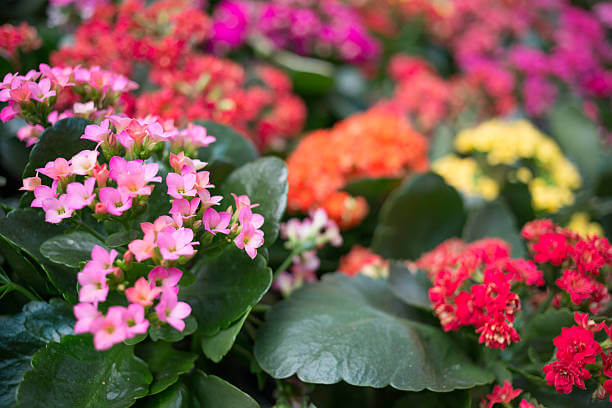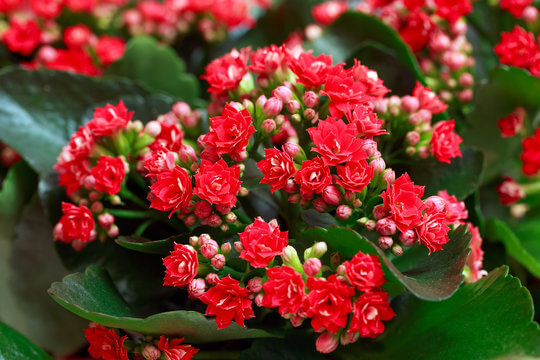Plant overview
The thick-leaved succulents that can be seen in various florist shops and garden centers are generally Kalanchoe plants.
Kalanchoe scientifically known as Kalanchoe blossfeldiana is a popular durable flowering potted houseplant that can enrich the beauty of your home, office, or garden with very little maintenance. Besides Kalanchoe, it is popularly named flaming Katy, panda plant, or widow’s thrill.
It was introduced by Robert Blossfeld, a German hybridizer in the year 1932 and is native to Madagascar and closely related to the jade plant.
With dark green, thick waxy scalloped leaves, and four-petaled flowers in clusters of various pretty shades like red, pink, yellow, white, orange, and magenta above the foliage, it adds beauty to the garden and can brighten your indoors.
However, homeowners with pets should be very careful of this plant as all the parts of this plant are very toxic and can harm the pets.
However, homeowners with pets should be very careful of this plant as all the parts of this plant are very toxic and can harm the pets. Click To TweetTypes of a Kalanchoe plant
Kalanchoe is a slow-growing, long-lasting beautiful plant that blooms from winter to spring and has more than 100 unnamed species. But some of the important species that are used for cultivation are given below.
K. Mangini:
Popularly known as Chandelier’s plant, k. Mangini is a popular house plant that bears bell-like pendant flowers and is prized for its fleshy leaves.
K. porphyrocalyx:
Popularly known as Pearl Bells, these species have purple pendant flowers and consist of slender, rectangular leaves.
K. beharensis:
Popularly known as elephant ear kalanchoe, this species features large, velvety leaves that are pale silvery green in color.
K. pinnata:
Popularly known as cathedral bells and miracle leaf plant, this kalanchoe species bears tiny plantlets along its margins and have fleshy green leaves.

Care of the plant
Like other succulents, kalanchoe is a hands-off species that prefer heavy sunlight and well-draining soil. The places where it is grown outdoors prefer well-drained sandy soil.
It can grow well in limited water, but it requires a lot of sunlight. It thrives well in all suited temperatures but makes sure that it should not be touched by frost.
It generally flowers in the season of spring but as long as the light exposure is controlled, it can recur throughout the year.
Let’s learn about what conditions should be provided to kalanchoe to take proper care of.
Soil
Kalanchoe plant grows well on well-drained sandy soil outdoor. But indoors, it should be potted in soil that must not contain a lot of moisture. A proper soil for an indoor kalanchoe plant should have 50 percent potting soil with 50 percent cactus mix or 40 percent pertile and 60 percent peat moss.
You can also plant this plant in a clay pot to ensure proper drainage and avoid the moist condition of the soil.
Water
Do you have the habit of forgetting to water the plant? Or don’t you have time to water the plant?
Then kalanchoe will be the best pick for you.
Kalanchoe plant can thrive well in minimum water and need a complete saturation every week. Even in the winter season, it requires less saturation. Click To TweetThis plant can thrive well in minimum water and needs a complete saturation every week. Even in the winter season, it requires less saturation.
If you don’t let the soil dry, and water very often, the plant is more likely to show the sign of root rot.
Being succulent, the leaves of this plant can store water. So late watering may not create a problem for this plant.
Light
Kalanchoe plants that grow indoors require a lot of light to bloom, so the plant must be kept in a place where it can get an abundance of light. But it should not exposes to direct sunlight as it can scorch the leaves and reduces the chance of blooming.
Temperature
This plant is not picky as other indoor plants, the household environment can be sufficient and important for the growth of this plant.
Generally, it grows well with a temperature of 55 to 88 degrees Fahrenheit. So you don’t have to do anything for the growth of this plant. You just need to protect it from the frost.
Kalanchoe plants are not a good choice as outdoor plants in the zone of 10 to 12 at they can’t grow well in this environment.
Humidity
These plants are not fussy about air moisture levels and grow well in those areas having moderate humidity.
Fertilizer
Just like other plants, kalanchoe also can get benefits from the fertilizer. outdoor garden plants require a little more than single light fertilizer during the days of flowering that is the spring.
If flowering is a matter for you to consider, you can get fertilizer for the plant that has extra phosphorus.
Once a month, indoor plants should be given with well-balanced fertilizer blend during summer and spring. There is no requirement for fertilizer during winter.

Reblooming of plant
Kalanchoe may grow to rebloom next year with proper care. You just need to take the following care for reblooming.
- Shift the plant to a larger pot after flowering.
- Cut out the tall growth and well flower stems
- Keep it in a summy warm environment with well watering.
- Take the proper care of these plants during these days luke adjusts them to the outdoor environment and brings them back indoors during the frost time or just 3 months before the bloom time.
The plant that is exposed to naturally short day length can bloom or start flowering by January. So keep the plant exposed to the short day lengths during these days.
By the above procedures, you can make the kalanchoe plant rebloom after a year or next flowering season.
Kalanchoe plant propagation
Propagation of the Kalanchoe plant is very simple and beneficial for the growth of the plant. As the Kalanchoe grows, it produces offsets that can be used for propagation at any time. Besides it also can be propagated through stem cutting.
The process of stem cutting involves:
- With the use of a sharp knife, cut the segment of the stem from the mature plant. If you are propagating through the offsets, remove the offset from the parent plant.
- Let the cutting dry for a few hours, unless it is healed shut and calloused over.
- Once healed, dip the calloused end with the growth or rooting hormone.
- Plant the cutting in the soil.
- Place the plant in the brightly indirect sunlight for the growth and don’t water it for certain days.
Repotting of the plant
Most of the plant prefers pot bound but not the Kalanchoe plant. This plant grows well when well propagated with encouraging good drainage.
Kalanchoe plant should be repotted annually to encourage the growth of plants with the best results. But you have to ensure that the size of the container should be above the previous one with a good drainage system before doing repotting.
The soil used after repotting should be clay as it is porous and Kalanchoe grows well in this soil.
Plant problems
In house plants, plant diseases are the main problem. They require extra caring. Too much or too little water can result in the death of the plant. If the plant doesn’t get a proper soil mix, then root rot can be a serious problem for the plant.
Powdery mildew is a great problem for kalanchoe. It is also very difficult to recognize this problem as the only fine web will arise. Leaves feature the yellow spotting, ring or line spot patterns, dead flecks, and molted in this disease. Insecticides that contain potassium bicarbonate can be used to treat this disease.
Aphids, mealybugs, and brown scales are the common pests that cause diseases in this plant. In order to treat these plants, isolate them from other plants.
If it is affected by mealybugs, wipe the plant with alcohol with a cotton swab in order to control them. To treat brown scales, you just need to scrape them off and to treat aphids, you can remove them by hand.
You may also like to read
How To Grow and Care for Asparagus Plant?- A Complete Guide
Prayer Plant: How to Grow and Care for the Maranta Plant – Best Guide






